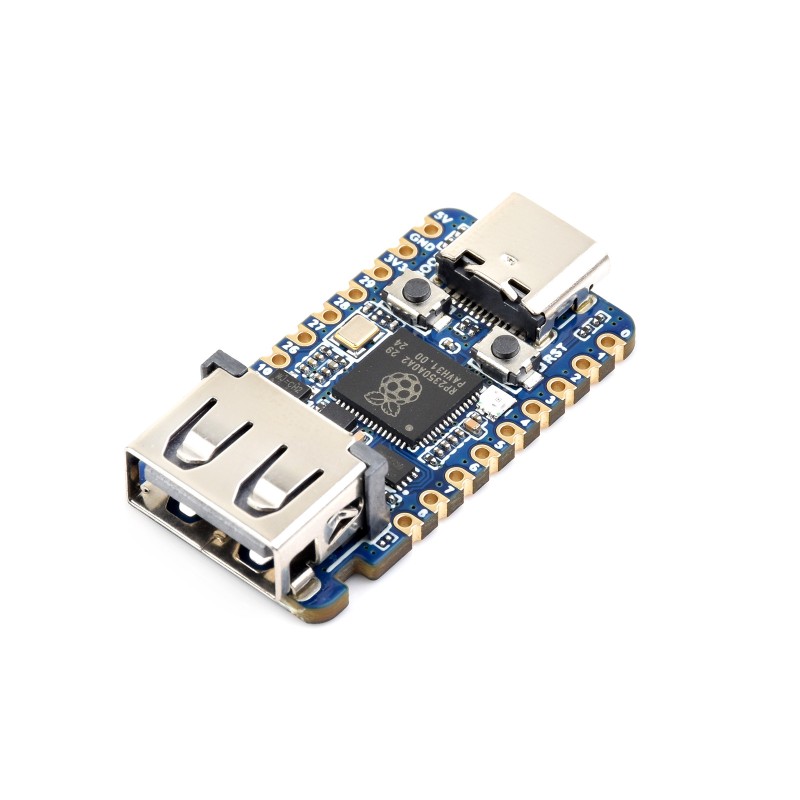







zł20.63 tax excl.
RP2350-USB-A is a versatile development board based on the modern RP2350A microcontroller with a unique dual-core architecture: Arm Cortex-M33 + RISC-V. Thanks to the USB Type-A port supported via PIO, a wide range of interfaces, and a compact form factor, the board is ideal for prototyping peripheral devices, learning programming, and integrating into custom projects as an SMD module.
RP2350-USB-A is a compact development board based on the RP2350A microcontroller designed by Raspberry Pi, combining a dual-core architecture of Arm Cortex-M33 and RISC-V Hazard3. The module offers a clock speed of up to 150 MHz, 520 KB SRAM, and 2 MB of Flash memory. The integrated USB Type-C connector enables easy drag-and-drop programming (mass storage), while the USB Type-A connector, supported via PIO, provides additional USB host or device functionality. The castellated edges allow for direct SMD mounting. Optimized for embedded and educational applications, it supports C/C++ and Arduino IDE.
Data sheet
Manufacturer BTC Korporacja sp. z o. o. Lwowska 5 05-120 Legionowo Poland sprzedaz@kamami.pl 22 767 36 20
Responsible person BTC Korporacja sp. z o. o. Lwowska 5 05-120 Legionowo Poland sprzedaz@kamami.pl 22 767 36 20
Development kit with RP2040 microcontroller equipped with two ARM Cortex-M0 + cores that work at 133 MHz, 264 kB RAM. The board has a QVGA camera, LCD display, IMU system and a microphone. ArduCAM B0302
No product available!
MicroMod main module with RP2040 microcontroller. Equipped with an M.2 connector, it can work with MicroMod expansion boards. SprakFun DEV-17720
Game console based on the RP2040 microcontroller from Raspberry Pi. Equipped with a 1.54" LCD display, LiPo battery and aluminum housing. It has API support that allows you to create your own games in C++ and MicroPython. Pimoroni PIM559
No product available!
Raspberry Pi Pico 2WH, based on the RP2350 microcontroller and has a built-in WiFi and Bluetooth communication module. Pi Pico 2WH offers significantly increased performance and functionality thanks to the use of Cortex M33 and RISC-V cores, doubled SRAM memory and advanced security features, including Arm TrustZone. It is hardware and software compatible with previous models, making it an attractive choice for enthusiasts and professionals in the field of embedded systems. Version with soldered joints.
No product available!
Module with the RP2040 microcontroller with two ARM Cortex-M0 + cores operating at 133 MHz, 256 kB RAM and 30 GPIO. The board also has 2 MB of external QSPI flash memory. Module can be programmed in C/C++ or microPython. Version with soldered connectors. Raspberry Pi SC0917
Development board with RP2040 and ESP-12E microcontroller. Equipped with 0.91" OLED display. SB Components 24186
RP2350-Touch-AMOLED-1.64-M is a compact board featuring the RP2350 microcontroller and an AMOLED display, equipped with touch input, motion sensors, and a full set of peripheral interfaces. Designed for modern mobile applications, HMI systems, and experiments with RISC-V and ARM architectures.
Development board based on the RP2040 microcontroller. It is equipped with a 1.14" color LCD display and a built-in debugging tool via USB interface. The board is enclosed in a plastic housing. Waveshare RP2040-GEEK
Module with LCD 2.4" display with a resolution of 320x240 px and RP2040 microcontroller. Equipped with QW/ST connector. Pimoroni PIM624
Board with RP2040 microcontroller and W5100S network chip. The module is equipped with an Ethernet connector. WIZnet W5100S-EVB-Pico
Base board with soldered Raspberry Pi Pico W module. Equipped with numerous connectors, buzzer, buttons and LEDs. Cytron MAKER-PI-PICO-MINI-W
Expansion module with a Raspberry Pi Pico W board equipped with WiFi communication. The module has a built-in relay, buffer inputs, sink outputs and analog inputs. Perfect for controlling fans, pumps, solenoid valves, large motors, electronic locks or LED lighting. Pimoroni PIM652
RP2350-LCD-1.28-B is a highly integrated development platform with a display, designed for applications requiring low power consumption and high flexibility in interface design. Thanks to its robust CNC enclosure and support for two processor architectures, the module is perfectly suited for use in portable systems, HMI devices, and intelligent embedded projects.
The first microcontroller designed by the Raspberry Pi foundation, equipped with two ARM Cortex M0 + cores clocked at 133 MHz, 264 KB of RAM and 30 ports with I2C, SPI, UART and USB interfaces. External flash memory can be connected via the QSPI interface. The system can be programmed in C / C ++ or microPython. Raspberry Pi SC0908
The RP2040 microcontroller board features two ARM Cortex-M0+ cores that operate at 133 MHz. It has 264 kB of RAM, and the board also includes 16 MB of QSPI Flash memory. The chip can be programmed in C/C++ or MicroPython. Board with connectors. Waveshare RP2040-Plus-16MB-M
RP2350-Zero enables rapid development of embedded applications while maintaining minimal mounting requirements and excellent flexibility in baseboard design. Particularly recommended for portable devices, educational use, and as a control module in larger systems.
No product available!

RP2350-USB-A is a versatile development board based on the modern RP2350A microcontroller with a unique dual-core architecture: Arm Cortex-M33 + RISC-V. Thanks to the USB Type-A port supported via PIO, a wide range of interfaces, and a compact form factor, the board is ideal for prototyping peripheral devices, learning programming, and integrating into custom projects as an SMD module.
